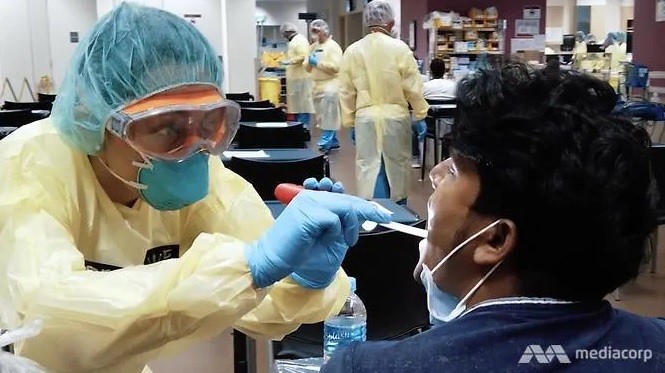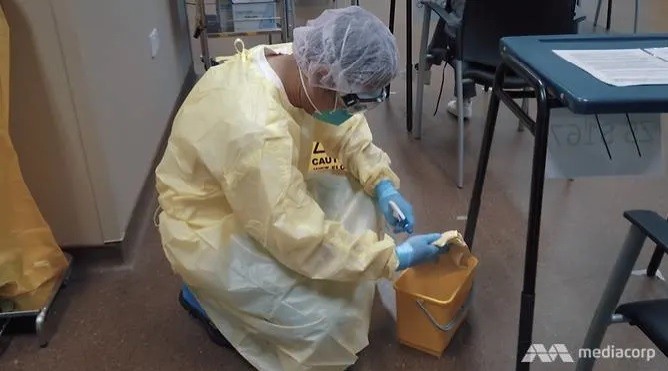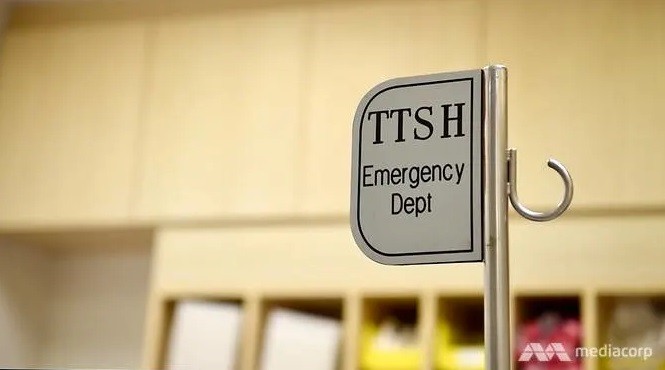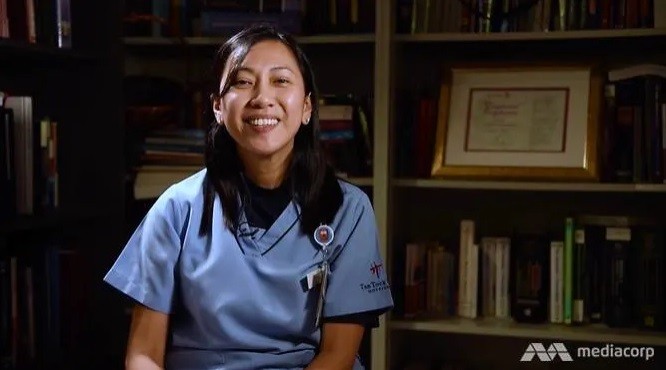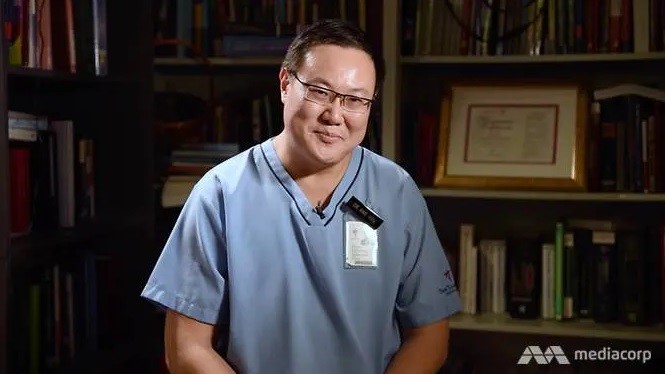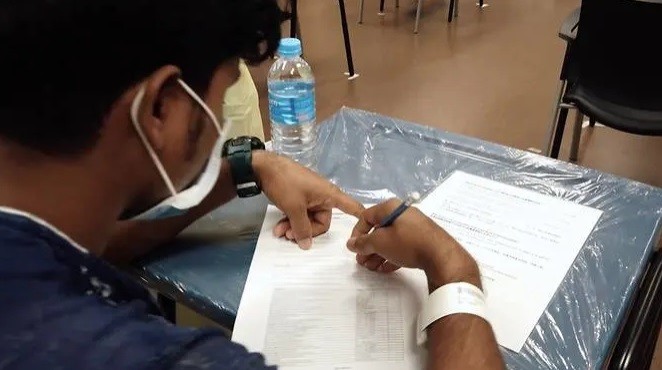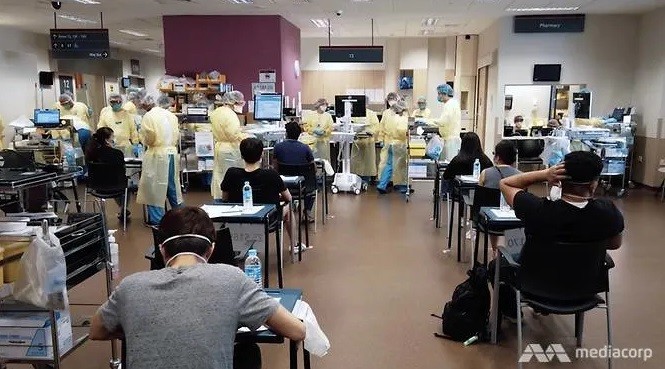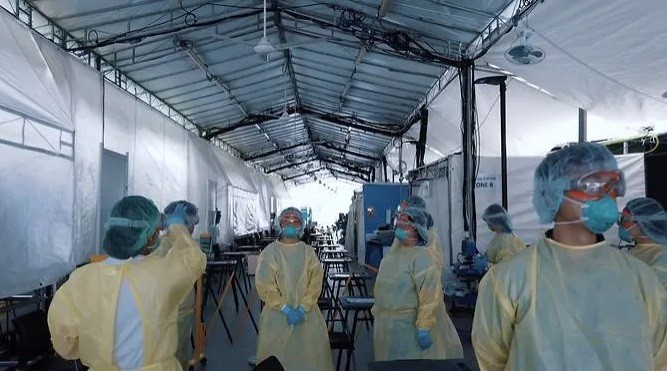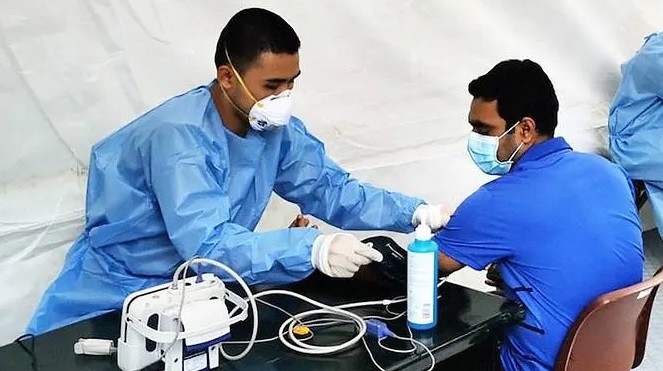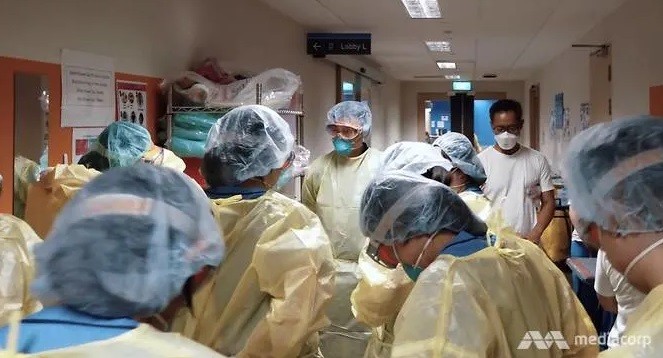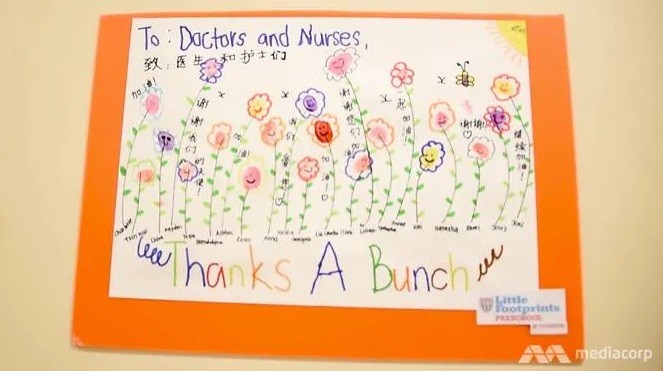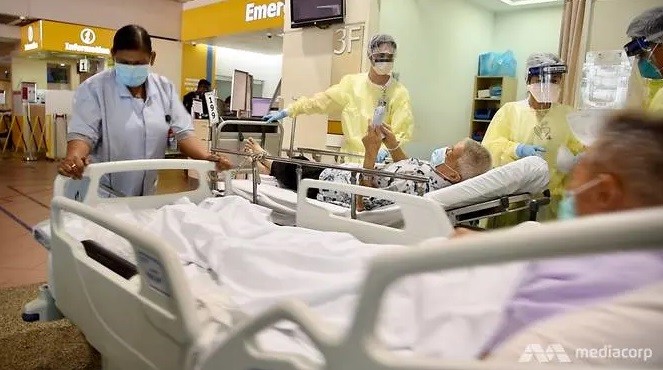Search the Community
Showing results for tags 'Nurses'.
-
If you have fifteen minutes to spare. This is quite harrowing to listen. 😥
- 52 replies
-
- 11
-

-

-

-
10, 20 years from now, we want to remember the faces behind the success of defeating COVID-19. No doubt about it, we will win the fight against the virus. Here's a thread out of the many COVID-19 ones, to remember the people behind our success. From Doctors, Nurses, Cleaners, Social Distancing Ambassadors, SPF, SAF, SCDF, NEA, ICA, MFA ... Let's share stories about these angels. Here's one from NCID to start. Inside Singapore’s COVID-19 screening centre, on the front line against the disease As the number of cases continues to rise, it is all hands on deck at Tan Tock Seng Hospital and the National Centre for Infectious Diseases, where doctors, nurses and other healthcare workers screen hundreds of patients daily. SINGAPORE: At the National Centre for Infectious Diseases (NCID) screening centre, one important part of the defence against the pandemic has been none other than ice cream. Charmaine Manauis is hardly joking when she says that. She is the lead consultant in infectious diseases at Tan Tock Seng Hospital’s emergency department, which is in charge of the screening effort. “Ice cream is important; it makes us happy. You see everyone — they have ice cream, they perk up,” the doctor said about her colleagues, and herself. “Plus, it’s hot inside the personal protective equipment. So they love eating ice cream (in the pantry) during their break.” She is certainly not kidding about feeling the heat under their yellow gowns, shower caps, gloves, goggles and N95 masks, which they wear throughout their seven- to 10-hour shifts, except during breaks. “When I remove my yellow gown, I’m usually drenched. It’s really hot,” she said. “When I remove (my mask), then I feel as if I can breathe again.” That is how it has been for the staff running both the TTSH emergency department and the NCID screening centre in the time of the coronavirus. And it is not just emergency doctors who are seeing to the suspected COVID-19 cases. While their department used to have about 20 doctors on shift at any time in the day, it has been a whole new ballgame since Chinese New Year. Hundreds of doctors across different specialities in the hospital — from urology to ENT (ear, nose and throat) to plastic surgery — are being mobilised for training so they can carry out COVID-19 duties too. Since Singapore’s first confirmed case on Jan 23, more than 400 doctors from the hospital have been rostered to work at the NCID screening centre across the road. And the one co-ordinating their training is Manauis, the senior consultant leading the screening efforts — as CNA Insider finds out in an inside look at the frontline battle against COVID-19. GETTING WIND OF THE VIRUS ON HOLIDAY The 42-year-old as well as her boss — Adjunct Assistant Professor Ang Hou, head of the emergency department — were on holiday in December when they first heard of a mysterious disease in Wuhan. “I said, ‘Hm, this might be something.’ So when I came back, the department had already started screening,” recounted Manauis. “We started screening for (travellers from) Wuhan on Jan 2.” That was the day Singapore’s Ministry of Health (MOH) announced that it was monitoring the pneumonia outbreak closely, and sent a circular to medical practitioners here. Whispers of the severe acute respiratory syndrome (SARS) started “floating around” TTSH. “We were SARS central back in 2003, so that’s never left the DNA of the department,” said Ang. “You can’t help but relive memories that you’ve been through, especially when you know your colleagues and your friends had been affected very deeply.” The possibility of a second coming did not surprise him, however. “We were always anticipating something like COVID-19 ... We knew that it wouldn’t be a matter of if, but when,” he said. “We knew that by the time it were to come from Wuhan to Singapore, it would’ve been ... a significant outbreak in the world or at least in this part of the region.” The department started screening for the novel coronavirus (SARS-CoV-2) in a “very small, dedicated space”. But even “way before” Singapore’s Disease Outbreak Response System Condition alert was raised to orange, the number of people coming every day “was growing to a scale that we had to move out of (that) physical space”, he added. As the rest of the country wound down for Chinese New Year, furniture had to be moved in, and computers set up, for the NCID screening centre to be activated. “It was a very busy Chinese New Year for a lot of people, not because we were going around celebrating but because we were preparing for the next phase in screening,” said Ang. By Jan 29, the screening centre was up and running round the clock. FROM SCREENING CENTRE TO TENT Those first few weeks of the centre’s operations were “really hectic” for Manauis. “We were on call 24/7. Every Saturday, we’d train (staff). During the week, we’d look at protocols — we’d look at whether our processes were working well, whether we had to manage any choke points in the screening centre,” she recounted. One of those choke points were the X-ray rooms. “If the screening centre was full, then there’d be a queue for X-rays. And so we’d need more efficiency, more radiographers,” she said. Based on the travel history and the chest X-ray results, the doctors had to decide whether the patients had to be warded or could be discharged. For those who needed admission, those were uncertain times. They had many questions. “How long will I stay? What tests will they be doing for me upstairs? How about my family? Do they need to be admitted too?” cited Manauis. The numbers coming for screening kept rising until the load “became quite difficult at one point”, said Ang. That came about when the MOH changed the definition of a suspect case, following the transmission of the coronavirus at a health products shop visited by Chinese tourists. “That led to a lot of patients being referred by their doctors for screening because they’d come into close and frequent contact with travellers from China,” said Ang. “A lot of people in various industries came in, whether they were taxi drivers, tour bus drivers, people who worked in tourist attractions or hotels, airports and casinos. They were all flooding in.” So, after consulting the ministry, TTSH proceeded to swab and discharge these patients, “to conserve beds for patients who were really ill and needed treatment”. Then there was “a strange point in time”, when the number of people coming for screening and the cases confirmed as positive slowed down, even as the numbers were picking up in the rest of the world. “We knew that the numbers would go up sooner or later,” said Ang. “We knew that the screening centre might not be able to cope ... so we made the decision together with the ministry to set up a tentage, to expand the number of places available.” That ended up being the case. On March 23, the TTSH team screened the highest number of people until now: More than 520. “We call it the most terrible Monday,” said Manauis. “The patients came in the afternoon and at night. And at night, we have less manpower. We had to open the tentage until 3am, with a lot of patients having to wait a little bit longer. So that was a struggle.” MIGRANT WORKERS A NEW CHALLENGE There are still hundreds of patients screened daily, although the challenge as of late is not the numbers but the space needed, as the spike has been among migrant workers, and the tent outside the screening centre is “perennially full”. “For these foreign workers, we need to wait for swab results before they can be discharged (if they test negative). So we need a bigger waiting area for them,” said Manauis. “After that, they have to wait for transport also, to bring them back to their dorms. So they can wait for as long as, probably, 18 (to) 20 hours.” WATCH: An exclusive look inside the NCID screening centre (Dur 5:20) While there are now Swab Isolation Facilities like the CherryLoft chalets — where the workers can be sent after their nose swabs — these facilities “are quite full” nowadays, she added. The workers are otherwise unable to self-isolate. "Every day, we’d have to ask whether there’s any vacancy, and then they still need to wait for an ambulance or dedicated transport." While there is swabbing done at the dormitories now, some of the workers need to go to the screening centre depending on their symptoms. If they complain of chest pain or have difficulty breathing, for example, then they need an X-ray, a blood test or an electrocardiogram. As long as they are symptomatic or have had close contact with a positive case of COVID-19, they should be swabbed. An MOH circular sent on Thursday has also updated the swabbing criteria for everyone. Anosmia — the loss of the sense of smell, either total or partial — is now one of the symptoms to look out for, cited Manauis. “There were (research) papers that came out, and there were positive cases which presented only with anosmia,” she explained. The other symptoms still include fever, runny nose, cough, sore throat and gastrointestinal symptoms like diarrhoea or vomiting. Since she started on TTSH’s clinical protocols and work instructions for COVID-19 screening and infection controls, Manauis has developed 61 versions for the staff to follow. There is also a workflow for the foreign workers from dormitories, which is at version 17 now. IN FOR THE LONG HAUL She has also trained nine batches of doctors from various departments, with as many as 51 physicians in a batch. They work a 10-day cycle as part of a group of more than 100 people, including nurses and other healthcare workers, running the screening centre. Most of them, even senior specialists, are volunteers, and some have done more than one rotation, although each department is also supposed to contribute a certain amount of manpower. “Screening is very different from what they do every day. So it wasn’t a surprise that they were a little bit apprehensive. But they were very willing to help out,” said Manauis. She is grateful for all the support. At one of the training sessions this month, she told the doctors: “We really need your help on the front line. On behalf of the emergency department, I thank you guys for volunteering.” The thing is, her department is not only working at the screening centre, but also attending to the usual emergency cases. To do this, the staff have cancelled their leave and reduced their days off. “You just have to do your work. I go day by day — whatever needs to be done, needs to be done,” she said with a shrug. “Everyone’s made sacrifices, not only me or not only the doctors ... But we do this willingly because we know that this is our job.” The emergency cases are tended to in a different zone, although that does not mean the staff necessarily get to dispense with personal protective equipment. The forward screening triage nurses, for example, must wear the full equipment. “Sometimes walk-in patients ... are close contacts (of a COVID-19 case), so we have to protect our frontline staff,” said Manauis. To protect the patients as well, one of the changes made is to ensure that they queue at least two metres apart. This, and many of the current arrangements in the emergency department, could be in place for some time. “For those of us who’ve been here for a while, who’ve gone through other outbreaks, we know that, potentially, it’s going to be long-drawn,” said Ang. “It could affect some of our own members — that the memories of SARS come back — and I think it might hit those (employees) a little bit harder.” When asked on Friday about her team’s morale, Manauis, who has been with TTSH for 15 years, gave a cheerful reply. “We’ll try our best to ... help the nation, especially now that (the number) of positive cases has been increasing,” she said. “We’re still okay. We still have ice cream, so we’re happy. I mean, you’ll need to try and pace yourself because we know that this is going to stay for a few more months.” https://www.channelnewsasia.com/news/cnainsider/inside-singapore-covid-19-screening-centre-defence-disease-ncid-12656312?cid=fbcna&fbclid=IwAR2aRtq_Z2MAo0V4ZhWSMMaT9GnvC_-dupS3ZWBKls8QOzPkW7931n7Pa0M
- 105 replies
-
- 12
-

-
- healthcare
- doctors
- (and 7 more)
-
some patients really too much....
-
Another reason not to get sick. India-Singapore to sign a pact for movement of nurses http://economictimes.indiatimes.com/articleshow/45111352.cms?utm_source=contentofinterest&utm_medium=text&utm_campaign=cppst
-
SINGAPORE: Health Minister Gan Kim Yong has said his ministry is currently undertaking a review of salaries for nurses in Singapore. He said this is to make sure salaries remain competitive and to attract more locals to the profession. Mr Gan was speaking to reporters as he celebrated Nurses Day with nurses from Jurong Health Services on Monday. He said: "We will have to review the nurses' remuneration as well as the terms of employment, conditions of employment in workplaces. "We need to take a more comprehensive review - not just about salary - to see how we can lighten their workload, to make sure their workload is more rewarding, and provide more career opportunities. "As I have mentioned, we already have three career pathways - we will have to see how we can enhance them." Mr Gan said he hopes that when more locals join the profession, they will be able to take on more important roles and functions in the hospitals. Stakeholders say any adjustments in salaries are expected to help address the current manpower crunch, even though the sector's attrition rate has gone down from 12 per cent in 2005 to 9 per cent in 2010. The Ng Teng Fong General Hospital in Jurong, for example, requires about 1,400 nurses when it opens its doors in 2014. But its management has only recruited about 640 nurses so far. One-in-two of the hospital's nurses are foreigners, while the national average is currently 1-in-5 of some 30,000 nurses here. However, the hospital is optimistic it will be able to make up the shortage and welcomes the salaries review. Ms Kuttiammal Sundarasan, director of nursing for Alexandra Hospital and Jurong Health Services, said: "These days, our nurses' role (has) expanded and I think it is timely that our nurses' (pay) is being reviewed. "They want more training opportunities - our locals actually want to be better educated now, they just don't want to stop at diploma, they want to have degrees and masters. So we need to actually publicise and tell them there are plenty of those opportunities." To address the shortage of nurses, the hospital is also looking into re-employing more older nurses who have reached the age of 62. Mr Gan said with the re-employment law kicking in next year, hospitals should also further explore how they can retain nurses who retire at 62. Separately, he said the ministry is also assessing whether some projects need to be brought forward to address the hospital bed crunch. He said one possibility is to bring forward the completion of Sengkang General Hospital, which is currently slated to open in 2020. - CNA/al Finally, after so many years. If you go to any government hospital, you will see many FT nurses. Not many sporean wanna work as a nurse. Lowly paid, long hours, high responsibilities, no recognition,..etc. Only good thing is job security..
-
STOMPer 1122 was shocked to see nurses smoking while still in their uniform. They are not presenting a good image to the public, especially since they are in the healthcare service. Wrote the STOMPer (Sep 8): "Nurses smoke in public! Is this a good example? "I was so shocked when I saw these two nurses smoking with their uniform on! "This is so outrageous! They are not presenting a good image to our young children! "If you zoom in, the nurses are smoking together! "Smoke can be seen coming out of the nurse's mouth (the one wearing a dress)! "It also gives the healthcare sector a bad image. "Nurses are supposed to uphold the image of health and hygiene, as they need to handle patients. "I saw them at Ang Mo Kio, I think they are student nurses." Actually they have their rights too.I ever seen Medical Officer smoking in camp. Most important thing is they perform their duties while on job.Then again,images effect.Mostly valuable to stake holders. But if you ask Throttle.....he will say so long as you don't inhale,fiddling within the mouth is ok. I got to admit Throttle is a real clever person in truth.
-
Someone in the healthcare service told me abt this.... Nowadays nurses need to be in good shape. (BMI)must be within the satified range. Any extra fats,out of shape, look funny, you are out of the league. This is a just one pre-recruitment criteria. Many hospitals have set this high standard. And even during work, they are told to put on make up to look good . Some nurses that i know lament all this requirements. Bad news for those who are fat but inspired to be nurses. Well, they may not be so lucky now. For the veteran, they too are given time and notice to work on the extra pounds. PAI TAN!!!!!

